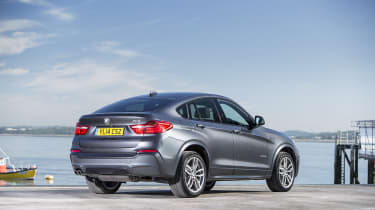BMW X4 SUV (2014-2018)
“The BMW X4 is a compromised SUV that places more emphasis on style than versatility”
Pros
- Plenty of technology as standard
- Good grip and handling
- Pretty stylish looks
Cons
- Not very practical
- Diesel engines only
- Pricey compared to rivals
The BMW X4 is a niche version of the BMW X3 SUV, with a coupe-like roofline to make it more stylish. Underneath, it uses the same engines and technology as the X3, but it’s less practical and more expensive.
Following in the footsteps of the larger BMW X6, the X4 still has the ride height of an SUV, but the styling of a four-door coupe. For passengers, this means less room in the back, while the driver will struggle to see out when reversing.
Three trim levels are available, with even the entry-level SE model offering 18-inch alloy wheels, xenon headlights, leather upholstery and a 6.5-inch display with sat nav. Costing around £1,500 extra, xLine adds a drive selector that lets you change driving modes, chrome tailpipes, sports seats, chrome exterior trim and ‘X’ logos embossed on the seats.
Major rivals for the X4 include the Audi Q5 and Lexus NX, as well as the more expensive versions of the Range Rover Evoque and cheaper versions of the Range Rover Velar.
Costing almost £4,700 more than SE, upgrading to M Sport trim adds 19-inch alloy wheels, sports suspension and more aggressive bodywork with gaping front air intakes.
More reviews
In-depth reviews
The X4 is offered with three diesel engines, starting off with a 2.0-litre badged X4 xDrive20d. Power is a respectable 187bhp, getting the X4 from 0-62mph in just eight seconds. The 3.0-litre xDrive30d and xDrive35d are even faster, with 255 and 309bhp respectively. Both can dispatch the 0-62mph dash in less than six seconds, making them quicker than most hot hatchbacks.
Only the 2.0-litre version comes with the option of a manual gearbox, but the smooth-shifting automatic suits the X4’s character better anyway. With eight speeds, it can be left to its own devices, or controlled via the paddles on the steering wheel should you wish to take the reigns yourself.
The mid-range 30d engine is available in both xLine and M Sport trim. It has six cylinders, as does the more powerful 35d, which is only available as an M Sport. It produces 309bhp and gets the car from 0-62mph in a rapid 5.2 seconds.
As regards fuel economy, the 20d engine in entry-level SE trim returns up to 55.4mpg and emits 135g/km of CO2, while the most powerful 35d returns 47.1mpg and average CO2 emissions of 157g/km, according to BMW.
Our choice would be the entry-level 20d, as it strikes the best balance between performance and economy. Regardless of what engine you choose, the X4’s sharp steering and decent handling are a welcome change from other tall SUVs, however the CO2 emissions vary between models, even with the same engine - due to the size of the wheels - so company-car drivers will need to check this out, just in case it bumps the car into a different Benefit-in-Kind (BiK) tax bracket.
If the X4 is beyond your budget, we’d recommend the entry-level Land Rover Discovery Sport or the Audi Q3, which offer similar performance to the 20d version. The Mazda CX-5 SUV is also cheaper, but still pretty stylish. All of these are more practical, while BMW's own X3 offers more space, the same range of engines and lower prices than its sister model.









